I haven't provided detailed commentary on the US labour market for a while now. To…
Australian labour market – part-time trend intensifies as total employment declines
The last few months Australian Bureau of Statistics data has shown that Austrlia is becoming a nation of part-time employment – in the 12 months to July 2016, 84 per cent of net employment created has been part-time and underemployment (workers desiring more hours but unable to find them) has risen. The latest labour force data released today by the Australian Bureau of Statistics – Labour Force data – for August 2016 shows that trend to be intensifying with negative employment growth and sharply a declining participation rate. With more than 82.3 per cent of total net jobs created over the last 12 months being part-time, it is clear that Australia maintains its status as the nation of part-time employment growth with all the attendant negative consequences. Further, the only reason that the unemployment level and rate fell is because the labour force shrank faster than total employment. This was due to the 0.2 percentage point decline in participation. The teenage labour market remains in a poor state and requires urgent policy intervention. Overall, with weak private investment now on-going, the Australian labour market is looking in pretty dismal shape and the recently elected Federal government should have introduced a rather sizeable fiscal stimulus immediately upon re-election to provide some fiscal leadership to the nation. This should have included a large-scale public sector job creation program which would ensure teenagers regained the jobs that have been lost due to the fiscal drag over the last several years. There are no signs that our polity understands any of that.
The summary ABS Labour Force (seasonally adjusted) estimates for August 2016 are:
- Employment decreased 3,900 (-0.03 per cent) with full-time employment increasing by 11,500 and part-time employment declining by 15,400.
- Unemployment fell by 10,500 to 713,300 but only because the participation rate fell sharply.
- The official unemployment rate fell to 5.6 per cent (0.1 points).
- The participation rate declined by 0.2 points to 64.7 per cent. This is well below its November 2010 peak (recent) of 65.8 per cent.
- Aggregate monthly hours worked decreased 3.9 million hours (-0.24 per cent).
- The quarterly ABS broad labour underutilisation estimates (the sum of unemployment and underemployment) will next be updated in the September 2016 release. In the May quarter, underemployment rose by 10.8 thousand at 8.4 per cent of the labour force. The total labour underutilisation rate (unemployment plus underemployment) rose by 0.1 per cent to 14.2 per cent. There were 1,067.3 thousand persons underemployed and a total of 1,801.5 thousand workers either unemployed or underemployed.
- The monthly underutilisation estimates show the situation has deteriorated since May. In August 2016, there were 1081.4 thousand underemployed persons or 9.1 per cent of the labour force. Total underutilisation stood at 14.6 per cent.
Employment growth – negative in August
In seasonally-adjusted terms, total (net) employment in August 2016 is estimated to have decreased 3,900 jobs with full-time employment increasing by 11,500 and part-time employment declining by 15,400.
The ABS said that in terms of its trend data:
In August 2016, trend employment increased by 9,900 persons to 11,965,100 persons – a monthly growth rate of 0.1 per cent. Trend part-time employment growth continued, with an increase of 10,200 persons, while full-time employment decreased by 400 persons. …
Which consolidates the interpretation that the Australian economy is becoming dominated by part-time work – with the attendent ramifications of low-pay, precarious attachments and other negative characteristics.
In seasonally-adjusted terms, 82.3 per cent of the net jobs created in Australia in the last 12 months have been part-time.
Over the last 6 months this trend intensified, with full-time employment going backwards and part-time employment accounting for 120 per cent of the net job creation (see below).
The zig-zag pattern that we have observed over the last 36 months or so – where the employment estimates have been switching back and forth regularly between negative employment growth and positive growth with the occasional spikes – continues.
The following graph shows the month by month growth in full-time (blue columns), part-time (grey columns) and total employment (green line) for the 24 months to August 2016 using seasonally adjusted data.
It gives you a good impression of just how flat employment growth has been over the last 2 years. You can also see the dominance of part-time employment growth over the same period, especially in the last year or so.
The following table provides an accounting summary of the labour market performance over the last six months. The monthly data is highly variable so this Table provides a longer view which allows for a better assessment of the trends. WAP is working age population (above 15 year olds).
Full-time employment has fallen by 15.5 thousand jobs (net) while part-time work has risen by 93.1 thousand jobs. Thus, 120 per cent of the total employment created (net) over the last 6 months has been part-time.
The conclusion – overall there have only been 77.6 thousand jobs (net) added in Australia over the last six months while the labour force has increased by a very modest 62.4 thousand. Employment growth has thus outstripped the sluggish labour supply growth with the result that unemployment has fallen by 15.2 thousand.
Employment growth (particularly the quality of the jobs) has been weak by historical standards given that the labour force growth has been very subdued, and labour force participation has declined markedly (-0.2 percentage points). The participation rate remains at depressed levels.
Overall – a fairly subdued labour market.
The following graph shows employment indexes for the last 3 recessions and allows us to see how the trajectory of total employment after each peak prior to the three major recessions in recent history: 1982, 1991 and 2009 (the latter to capture the current episode).
The peak is defined as the month of the low-point unemployment rate in the relevant cycle and total employment was indexed at 100 in each case and then indexed to that base for each of the months as the recession unfolded.
I have plotted the 3 episodes for 102 months after the low-point unemployment rate was reached in each cycle – the length of the current cycle.
The initial employment decline was similar for the 1982 and 1991 recessions but the 1991 recovery was delayed by many months and the return to growth much slower than the 1982 recession.
The current episode is distinguished by the lack of a major slump in total employment, which reflects the success of the large fiscal stimulus in 2008 and 2009.
However, the recovery spawned by the stimulus clearly dissipated once the fiscal position was reversed and the economy fell back into producing very subdued employment outcomes.
Since February 2008, employment has grown by a miserly 12.4 per cent, which is a very slow pace in historical terms for such a long period.
Given the variation in the labour force estimates, it is sometimes useful to examine the Employment-to-Population ratio (%) because the underlying population estimates (denominator) are less cyclical and subject to variation than the labour force estimates. This is an alternative measure of the robustness of activity to the unemployment rate, which is sensitive to those labour force swings.
The following graph shows the Employment-to-Population ratio, since February 2008 (the low-point unemployment rate of the last cycle).
It dived with the onset of the GFC, recovered under the boost provided by the fiscal stimulus packages but then went backwards again as the last Federal government imposed fiscal austerity in a hare-brained attempt at achieving a fiscal surplus.
The ratio began rising in October 2014 which suggested to some that the labour market had bottomed out and would improve slowly as long as there are no major policy contractions or cuts in private capital formation.
However, the peak in November is now gone and the ratio is once again in retreat or barely rising.
The on-going fiscal deficit is still supporting some growth in the economy as the spending associated with the mining boom disappears. But the deficit is clearly too small given the behaviour of the real aggregates.
The series declined by 0.1 points in August 2016 but remains 1.8 points below the April 2008 peak of 62.9 per cent.
Teenage labour market – further falls in full-time employment
The teenage labour market saw full-time employment falling by 1.4 thousand and part-time employment rising by 5.6 thousand (net) jobs in August 2016.
Total employment thus rose by 4.1 thousand (net).
The following graph shows the distribution of net employment creation in the last month by full-time/part-time status and age/gender category (15-19 year olds and the rest)
Over the last 12 months, teenagers have gained only 13.8 thousand (net) jobs overall while the rest of the labour force have gained 166.6 thousand net jobs. Remember that the overall result represents a fairly poor annual growth in employment.
However, full-time employment growth for teenagers over the last 12 months has been negative – down by 23.8 thousand.
The teenage segment of the labour market is being particularly dragged down by the sluggish employment growth, which is hardly surprising given that the least experienced and/or most disadvantaged (those with disabilities etc) are rationed to the back of the queue by the employers.
The following graph shows the change in aggregates over the last 12 months. It is as if the teenagers have not had a stake in the labour market either way (blue bars barely visible).
To further emphasise the plight of our teenagers, the following graph extends the time period from February 2008, which was the month when the unemployment rate was at its low point in the last cycle, to the present month (August 2016). So it includes the period of downturn and then the so-called ‘recovery’ period. Note the change in vertical scale compared to the previous two graphs.
Since February 2008, there have been only 1,316.2 thousand (net) jobs added to the Australian economy but teenagers have lost a staggering 89.8 thousand over the same period. It is even more stark when you consider that 126 thousand full-time teenager jobs have been lost in net terms.
Even in the traditionally, concentrated teenage segment – part-time employment, teenagers have gained only 36.2 thousand jobs (net) even though 791.2 thousand part-time jobs have been added overall.
Overall, the total employment increase is modest. Further, around 60 per cent of the total (net) jobs added since February 2008 have been part-time, which raises questions about the quality of work that is being generated overall.
To put the teenage employment situation in a scale context the following graph shows the Employment-Population ratios for males, females and total 15-19 year olds since February 2008 (the month which coincided with the low-point unemployment rate of the last cycle).
You can interpret this graph as depicting the loss of employment relative to the underlying population of each cohort. We would expect (at least) that this ratio should be constant if not rising somewhat (depending on school participation rates).
The facts are that the absolute loss of jobs reported above is depicting a disastrous situation for our teenagers. Males, in particular, have lost out severely as a result of the economy being deliberately stifled by austerity policy positions.
In the last few months, with the part-time employment situation improving, there has been some reversal in the downward trends in these ratios.
The male ratio has fallen by 10.8 percentage points since February 2008, the female ratio has fallen by 4.5 percentage points and the overall teenage employment-population ratio has fallen by 7.7 percentage points. That is a substantial decline in the employment market for Australian teenagers.
The other staggering statistic relating to the teenage labour market is the decline in the participation rate since the beginning of 2008 when it peaked in January at 61.4 per cent. In August 2016, the participation rate was just 54.5 per cent.
That is an additional 106.3 thousand teenagers who have dropped out of the labour force as a result of the weak conditions since the crisis.
If we added them back into the labour force the teenage unemployment rate would be 27.3 per cent rather than the official estimate for August 2016 of 18.2 per cent. Some may have decided to return to full-time education and abandoned their plans to work. But the data suggests the official unemployment rate is significantly understating the actual situation that teenagers face in the Australian labour market.
Overall, the performance of the teenage labour market remains poor. It doesn’t rate much priority in the policy debate, which is surprising given that this is our future workforce in an ageing population. Future productivity growth will determine whether the ageing population enjoys a higher standard of living than now or goes backwards.
I continue to recommend that the Australian government immediately announce a major public sector job creation program aimed at employing all the unemployed 15-19 year olds, who are not in full-time education or a credible apprenticeship program.
Unemployment fell by 10,500 to 713,300 but only because the participation rate fell sharply
The official unemployment rate fell to 5.6 per cent (0.1 points) in August 2016 but only because the labour force participation rate fell by 0.2 points as employment growth turned negative and workers clearly dropped out of the labour force.
In other words, the falling unemployment just resulted in a rise in hidden unemployment – a case where a declining unemployment rate is not a beneficial outcome.
Overall, the labour market still has significant excess capacity available in most areas and what growth there is is not making any major inroads into the idle pools of labour.
The following graph shows the national unemployment rate from February 1978 to August 2016. The longer time-series helps frame some perspective to what is happening at present.
After falling steadily as the fiscal stimulus pushed growth along, the unemployment rate slowly trended up for some months.
It is now above the peak that was reached just before the introduction of the fiscal stimulus. In other words, the gains that emerged in the recovery as a result of the fiscal stimulus in 2009-10 have now been lost.
Given the weak (negative) employment growth, the unemployment rate would be much higher if the labour force was growing as previous trend rates.
Broad labour underutilisation – upwards of 14.6 per cent
The monthly underutilisation estimates show the situation has deteriorated since the May quarterly results were released.
In August 2016, there were 1081.4 thousand underemployed persons or 9.1 per cent of the labour force. Total underutilisation stood at 14.6 per cent.
When the ABS last published its quarterly broad labour underutilisation measures for the May-quarter, total underemployment was 8.4 per cent (1,067.3 persons – up by 10.3 thousand since February) and the ABS broad labour underutilisation rate (the sum of unemployment and underemployment) was 14.2 per cent (up by 0.1 percentage points).
So the situation is deteriorating.
The following graph plots the history of underemployment in Australia since February 1978 to the May-quarter 2016.
If hidden unemployment (given the depressed participation rate) is added to the broad ABS figure the best-case (conservative) scenario would see a underutilisation rate well above 16 per cent at present. Please read my blog – Australian labour underutilisation rate is at least 13.4 per cent – for more discussion on this point.
The next update will be for the August-quarter 2016 and will be published published in the September 2016 Labour Force release.
Aggregate participation rate – declines by 0.2 points to 64.7 per cent and remains at depressed levels
The August 2016 participation rate decreased by 0.2 pts to 64.7 per cent. It remains substantially down on the most recent peak in November 2010 of 65.8 per cent when the labour market was still recovering courtesy of the fiscal stimulus.
Unemployment fell by 15.2 thousand this month but if the participation rate had not fallen in August 2016, total unemployment and the unemployment rate would have risen.
By how much?
The labour force is a subset of the working-age population (those above 15 years old). The proportion of the working-age population that constitutes the labour force is called the labour force participation rate. Thus changes in the labour force can impact on the official unemployment rate, and, as a result, movements in the latter need to be interpreted carefully. A rising unemployment rate may not indicate a recessing economy.
The labour force can expand as a result of general population growth and/or increases in the labour force participation rates.
What would have the unemployment rate been had the participation rate not fallen by 0.2 points?
The following Table shows the breakdown in the changes to the main aggregates (Labour Force, Employment and Unemployment) and the impact of the rise in the participation rate.
In August 2016, employment fell by 3.9 thousand (net) jobs was accompanied by a labour force decrease of 14,400 thousand. As a result, unemployment fell by 10.5 thousand.
In other words, unemployment because the labour force shrank faster than the fall in employment.
The falling labour force in August 2016 was the outcome of two separate factors:
- The underlying population growth added 16.1 thousand persons to the labour force. The population growth impact on the labour force aggregate is relatively steady from month to month but has slowed in recent months; and
- The fall in the participation rate meant that there were 30.5 thousand workers dropping out of the labour force (relative to what would have occurred had the participation rate remained unchanged).
- The net result was the fall in the labour force of 14.4 thousand (rounded).
If the participation rate had not have fallen, total unemployment, at the current employment level, would have been 743.8 thousand rather than the official count of 713.3 thousand as recorded by the ABS – a difference of 30.5 thousand workers (the ‘participation effect’).
Thus, without the fall in the participation rate, the unemployment rate would have been 5.9 per cent (rounded) rather than its current value of 5.6 per cent.
The conclusion is that hidden unemployment rose slightly in April 2016 while official unemployment rate remained unchanged.
There is considerable monthly fluctuation in the participation rate but the current rate of 64.7 per cent is a long way below its most recent peak in November 2010 of 65.8 per cent.
What would the unemployment rate be if the participation rate was at the last November 2010 peak level value?
The following graph tells us what would have happened if the participation rate had been constant over the period November 2010 to August 2016. The blue line is the official unemployment rate since its most recent low-point of 4 per cent in February 2008.
The red line starts at November 2010 (the peak participation month). It is computed by adding the workers that left the labour force as employment growth faltered (and the participation rate fell) back into the labour force and assuming they would have been unemployed. At present, this cohort is likely to comprise a component of the hidden unemployed (or discouraged workers).
In recent months the gap between the lines has diverged which signals a deteriorating situation.
Total official unemployment in August 2016 was estimated to be 713.3 thousand. However, if participation had not have fallen relative to November 2010, there would be 923 thousand workers unemployed given growth in population and employment since November 2010.
The unemployment rate would now be 7.2 per cent if the participation had not fallen below its November 2010 peak of 65.8 per cent. The official unemployment in August 2016 was 5.6 per cent.
The difference between the two numbers mostly reflects, the change in hidden unemployment (discouraged workers) since November 2010. These workers would take a job immediately if offered one but have given up looking because there are not enough jobs and as a consequence the ABS classifies them as being Not in the Labour Force.
There has been some change in the age composition of the labour force (older workers with low participation rates becoming a higher proportion) but this only accounts for less than 1/3 of the shift. The rest is undoubtedly accounted for by the rise in hidden unemployment.
Note, the gap between the blue and red lines doesn’t sum to total hidden unemployment unless November 2010 was a full employment peak, which it clearly was not. The interpretation of the gap is that it shows the extra hidden unemployed since that time.
This gap shrinks as participation rises relative to the November 2010 peak.
Hours worked – fell by 0.2 per cent in August 2016
Aggregate monthly hours fell by 3.9 million hours (-0.24 per cent) in August 2016 in seasonally adjusted terms.
The following graph shows the monthly growth (in per cent) over the last 24 months. The dark linear line is a simple regression trend of the monthly change – which depicts a negative trend
You can see the pattern of the change in working hours is also portrayed in the employment graph – zig-zagging across the zero growth line.
Conclusion
I repeat my standard monthly warning – we always have to be careful interpreting month to month movements given the way the Labour Force Survey is constructed and implemented.
Today’s figures show that employment growth has once again contracting confirming the pattern for some years now where the growth rate fluctuates between barely positive and negative.
The trend to increased part-time work strengthened in August 2016, even though the seasonally-adjusted outcome showed part-time work declining
With more than 82.3 per cent of total net jobs created over the last 12 months being part-time, it is clear that Australia maintains its status as the nation of part-time employment growth with all the attendant negative consequences.
The only reason that the unemployment level and rate fell is because the labour force shrank faster than total employment. This was due to the 0.2 percentage point decline in participation.
That is a sure sigh of a weak labour market – when employment growth is negative but unemployment falls!
The conclusion remains that the overall demand side of the labour market is very weak.
The teenage labour market remains in a poor state even though the 15-19 year olds enjoyed some part-time employment growth.
I consider this situation to warrant immediate attention by the Federal Government. The neglect of our teenagers will have a very long memory indeed and the negative consequences will be stronger given the ageing population.
The Federal government appears unwilling to address this dire issue.
That is enough for today!
(c) Copyright 2016 William Mitchell. All Rights Reserved
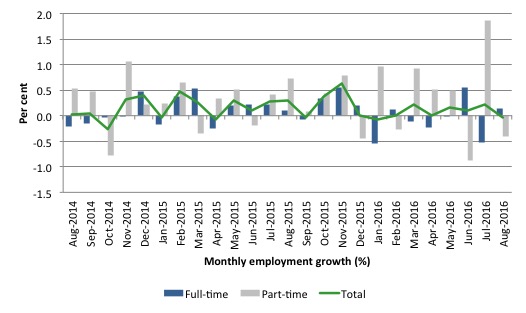
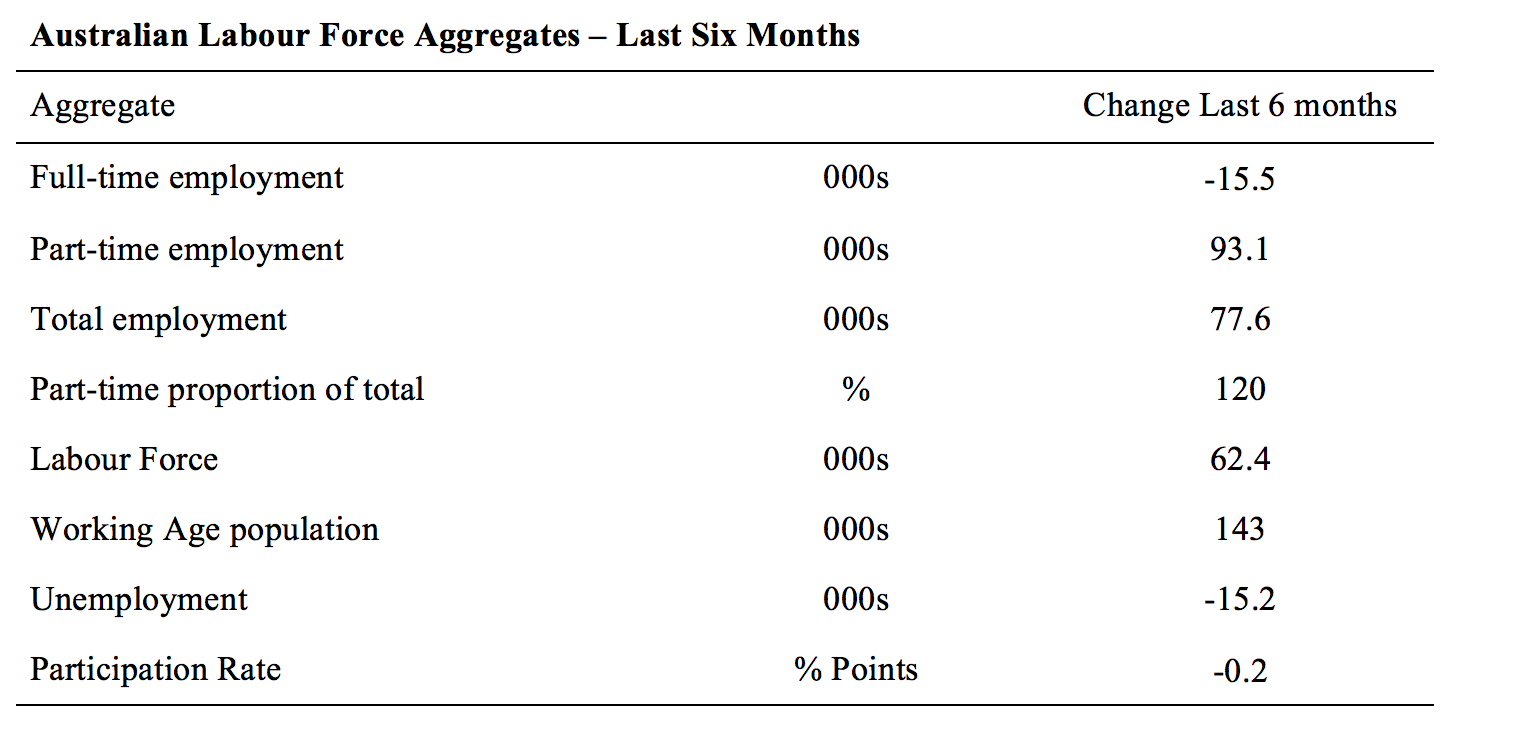


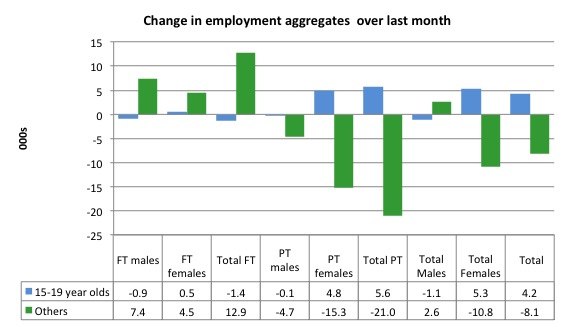

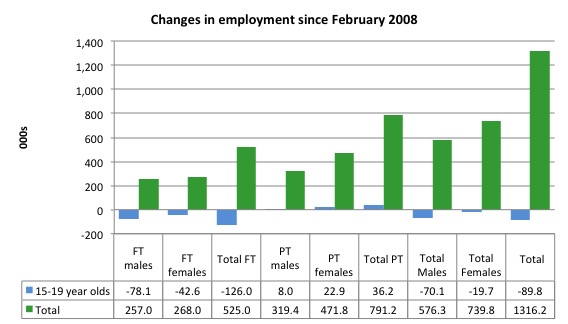


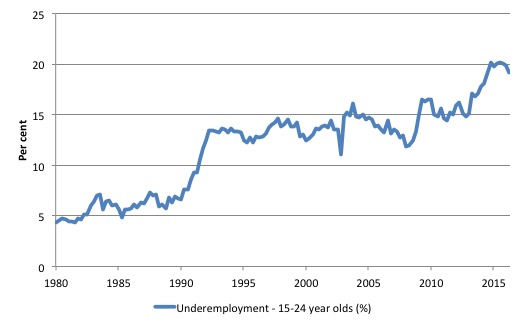
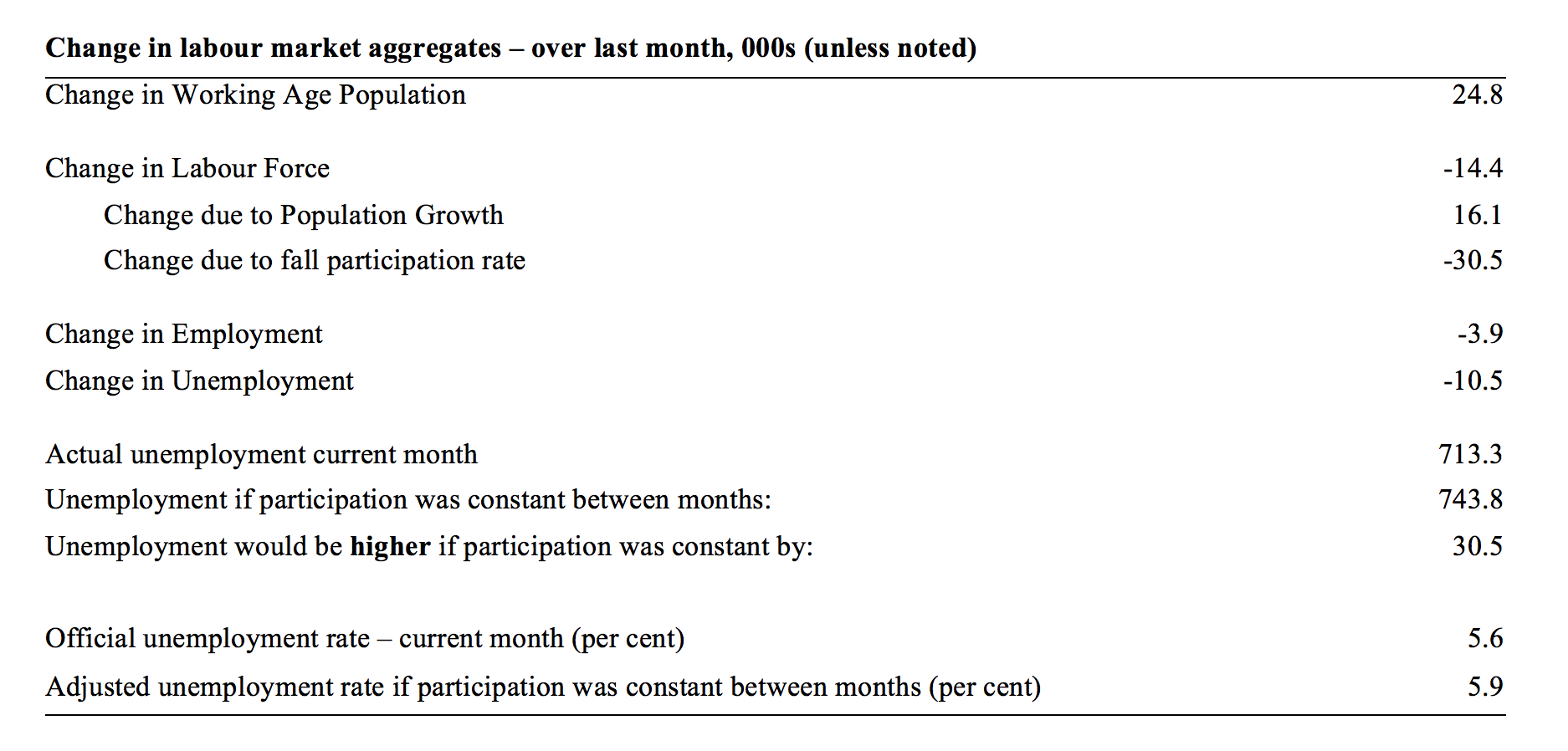
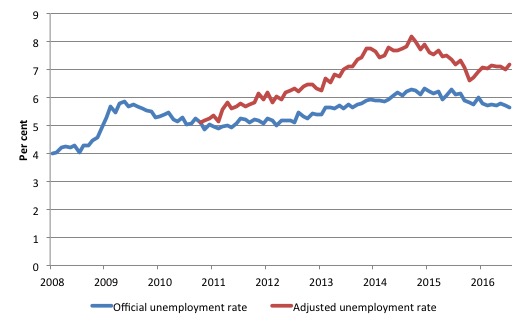

Would be nice if everyone jumped on and boosted the participation rate and gave the govt a real shock.
Bill,
In view of the perilous state of youth unemployment could the job guarantee be applied first to this group so as to avoid hysteresis effects in later years?
Bill….as a follow-up to the above, and eerily similar to what is happening in America….I am a long-term fan….and I would like your help with something…..the field of economics is awash in indexes to take the temperature of the economy, at any given time….but when I was running for Congress in the U.S., I could not find an index [an impacting “law” ] that warns of the adverse impact on corporate profits as a result of unemployment [so I crafted one, below-as much to underscore the issue]-i.e., there is no incentive in the capitalist model to end unemployment-and which, in turn, has a direct impact on our job creation policies. I have tried to outline the dilemma resulting from the above, in the following letter-admittedly rough around the edges, and any input from you would be greatly appreciated. Best, Jim Green
Presidential Innovation Fellows/Council of Economic Advisers:
There is no issue in this election of more importance than:
“How we create jobs as we go forward in the 21st Century”
And yet, its importance has been drowned out by demagoguery-WHEN this is what is at stake in our Job Creation in America:
Since WW II we have labored under the belief/propaganda that “the market can provide anybody wanting a job, with a job”-[and good business principles got lost in “it’s the American way”, and a Santa Claus-like belief that jobs would be created ]-
With the result that this method of Job Creation has not resulted in an unemployment [hereafter UE] rate below 3% since 1953!
But no one bothered to look at the data-and/or was blinded by tradition–or they would have realized that, given automation, alone, in a rapidly changing world, the above Job Creation model-DOESN’T WORK IN A MODERN MARKET ECONOMY……
And as a result our recovery since 2008 has limped along on a flat tire-it has taken us almost 8 years to shave an anemic 5% from our UE rate-and we still have 8 million looking for work, that can’t find any-per the “official” number-and the exact same number of unemployed that lost their jobs in the Crash, in 2008-8 million!
And while the downside to unemployment is, as it should be, focused on the devastation to the individual-common sense, alone, tells us that people do no buy what we manufacture, and profits are diminished, when they are jobless-hardly insignificant when the ripple-effect through our economy is from a cumulative 20 million unemployed/under-employed-per the best calculations….
Putting all else aside, UE is a No One Wins….the jobless lose, civility loses [Ferguson, etc.,], and the Market loses, to wit:
OUR SLUGGISH RECOVERY/ECONOMY RESULTING FROM THE LAW OF DIMINISHED INCOME TO THE MARKET FROM UNEMPLOYMENT [hereafter D/UE LAW]
3% is the zero-sum threshold above which unemployment triggers inflation by diminishing labor training and skills, under-utilizing capital resources, reducing the rate of productivity advance, increasing unit labor costs, reducing the general supply of goods and services–and the loss in income to the Market is compounded exponentially with each percentage point of increase in unemployment, above 3%.
Proposed Solutions: HR 1000 [in Committee]; THE NEIGHBOR-TO-NEIGHBOR JOB CREATION ACT [NTN], Amazon/Kindle
Jim Green, Democrat opponent to Lamar Smith, Congress, 2000
PS Apologize for CAPS-your software does not recognize intended emphasis.